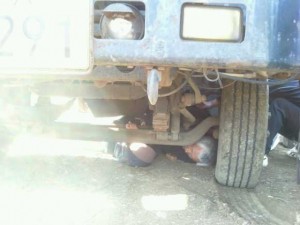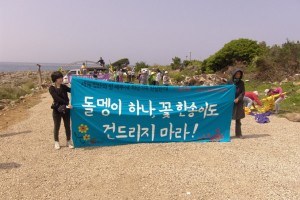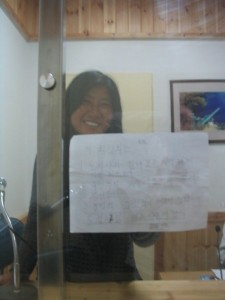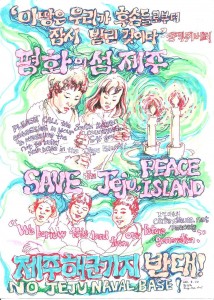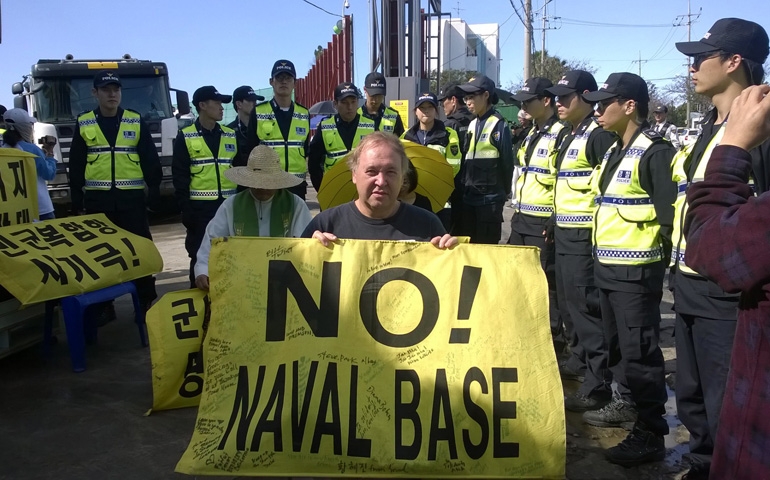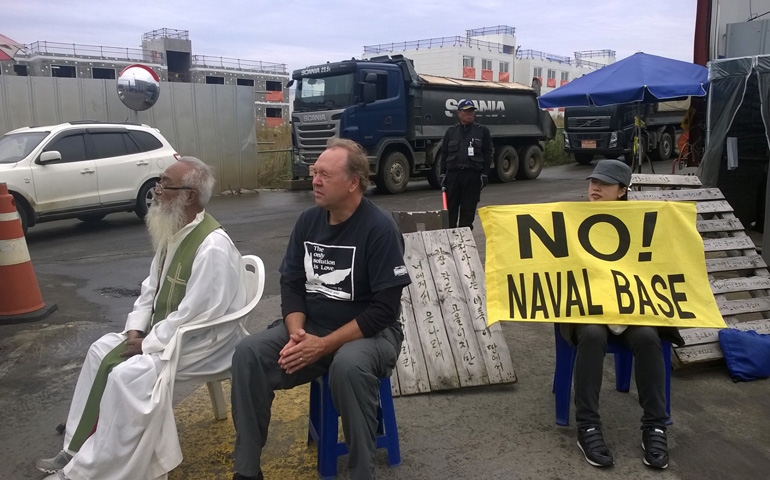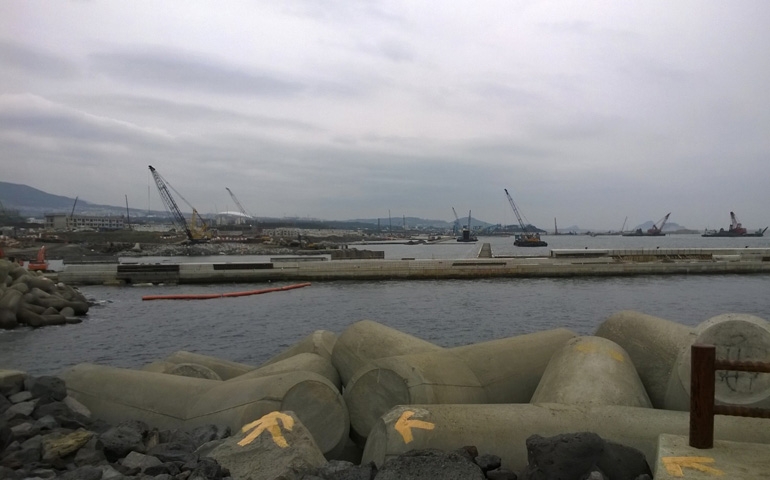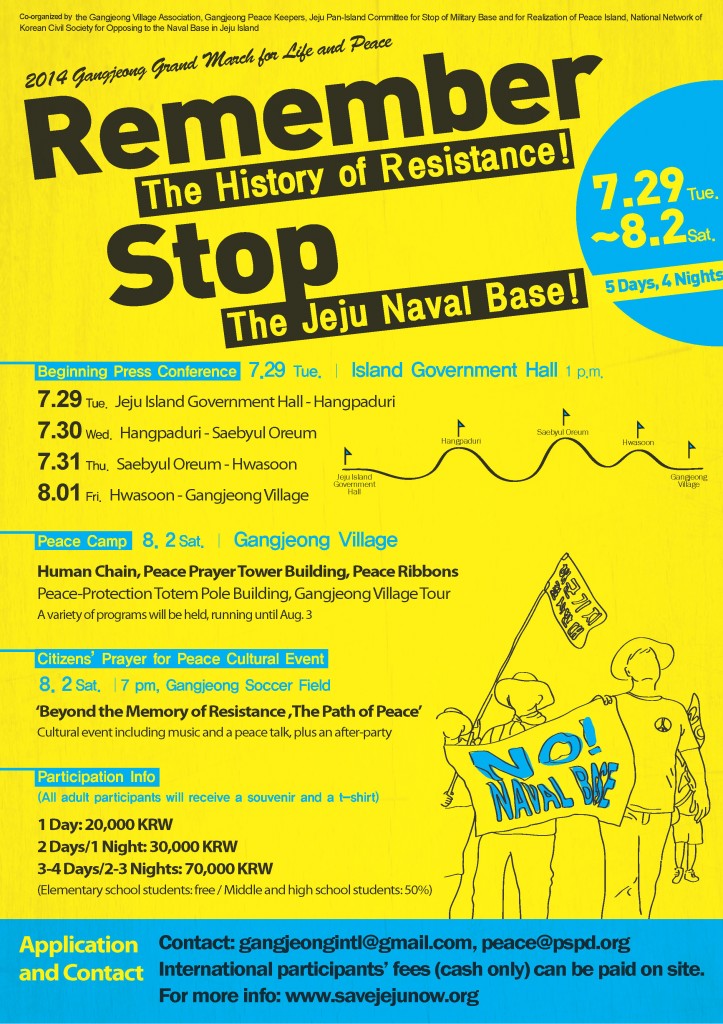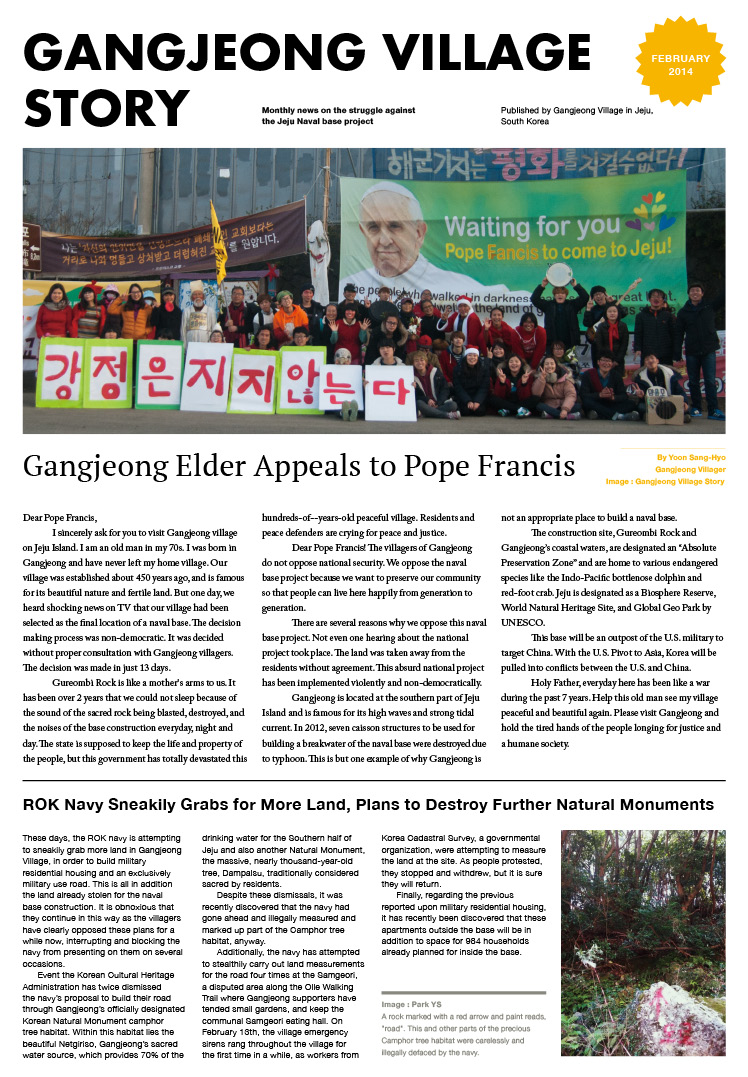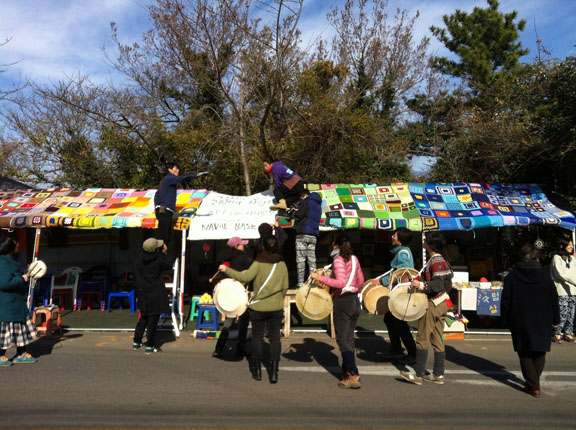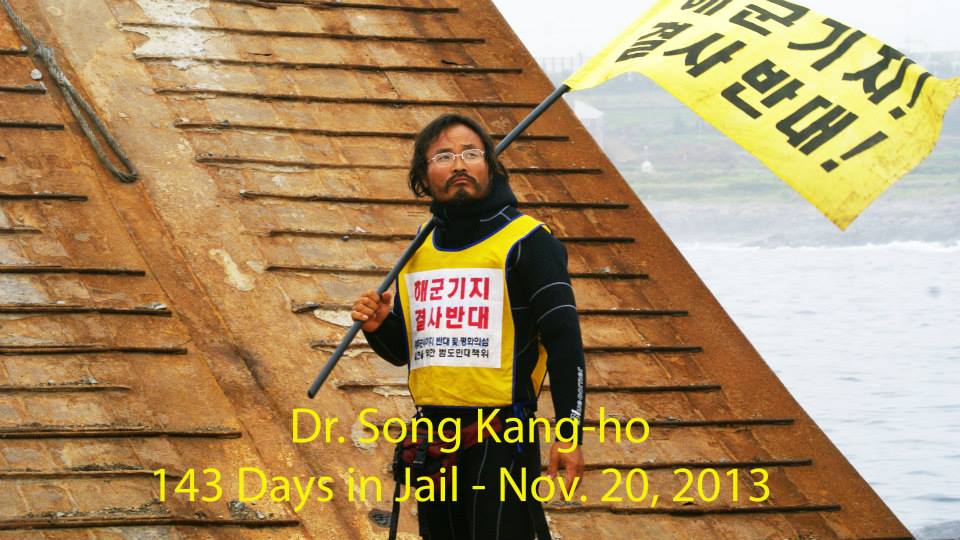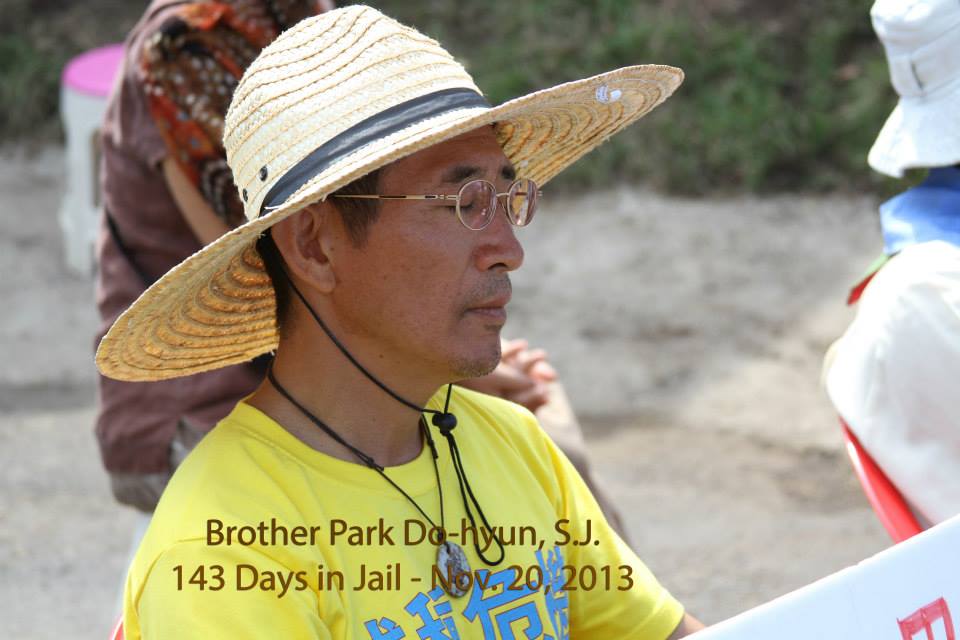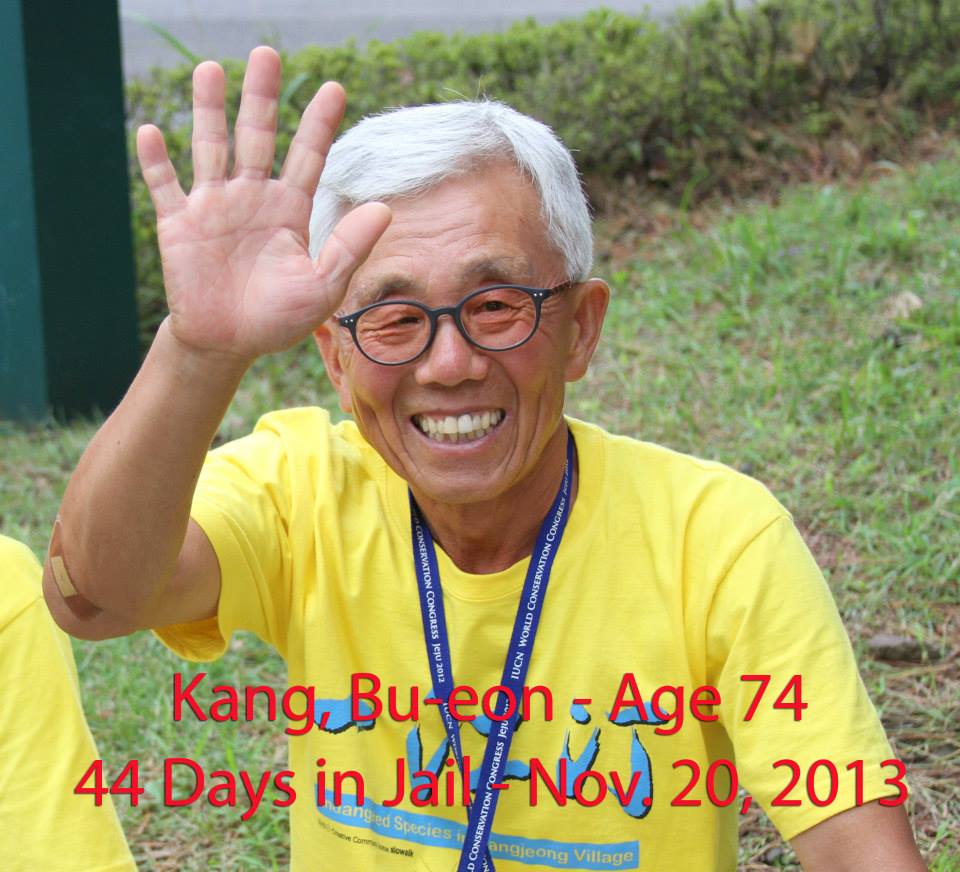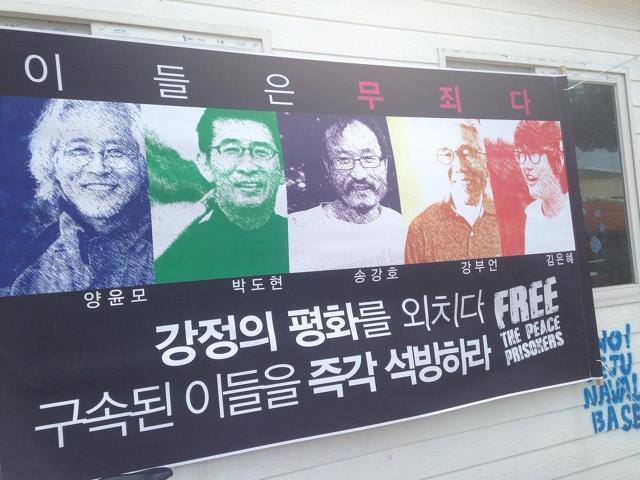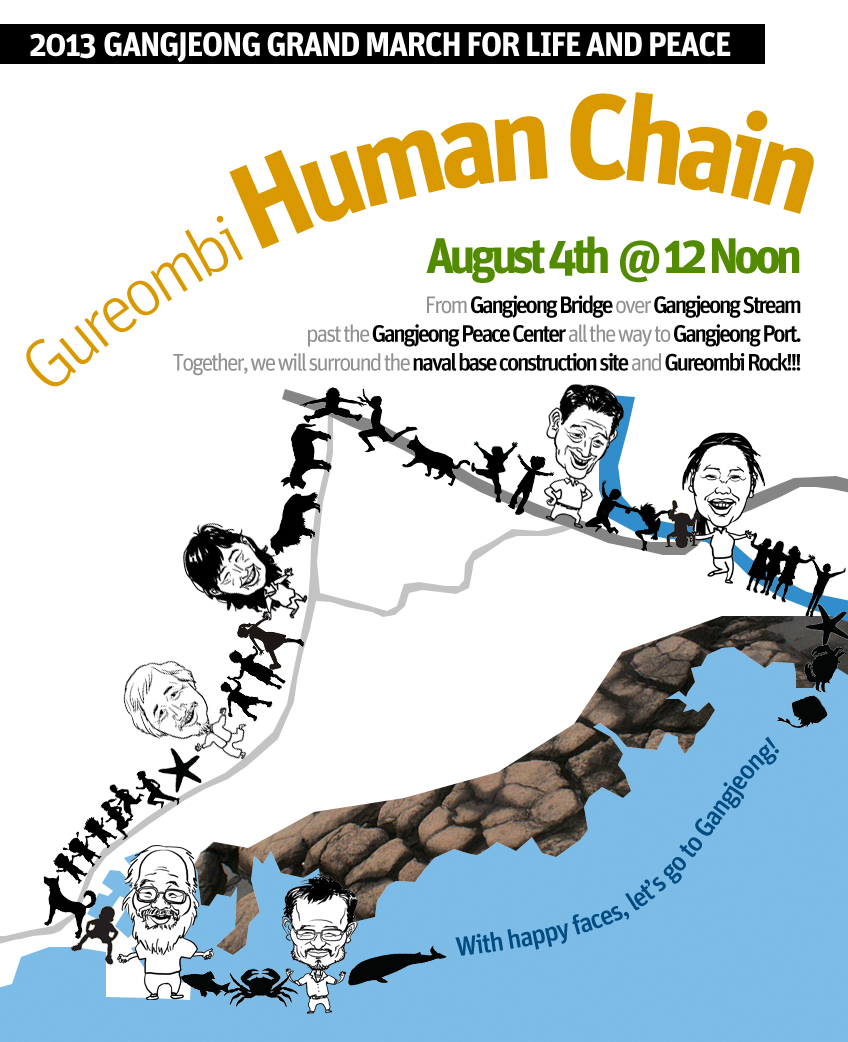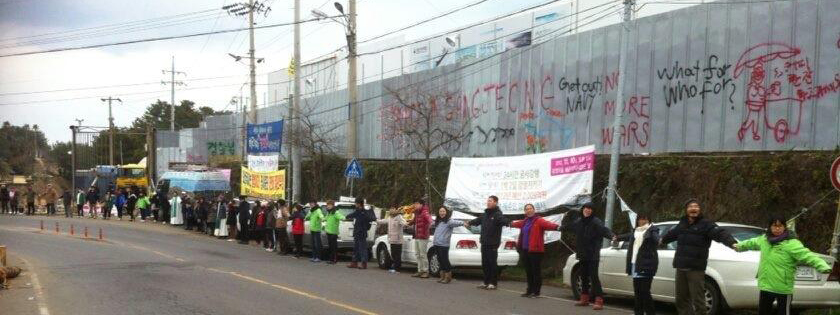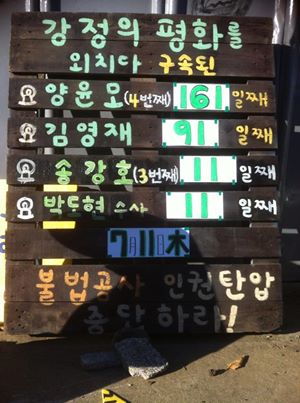See many March 1 event photos, here.
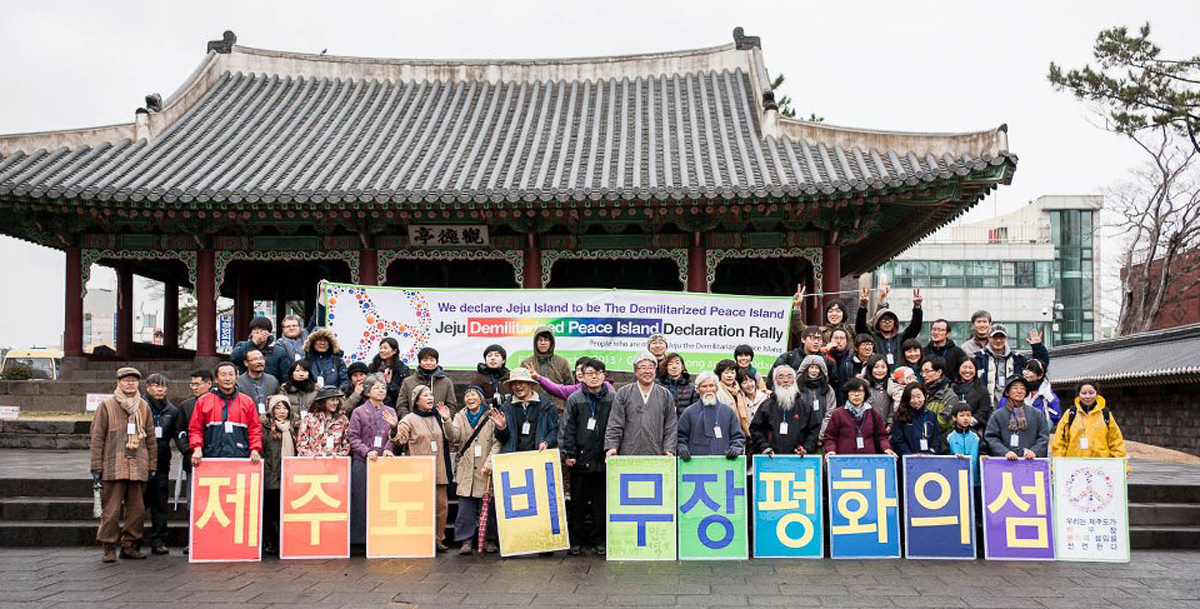
1. Yang Yoon-Mo reminds the history and vision of the Jeju
It was exactly here in Gwandeokjeong, Jeju City, March 1, 1947 when 6 people were killed by the constabulary governed under the US Army Military Government in Korea during their parade on commemorating independence movement on March 1, 1919. It was here when Hur Du-Yong, uncle of Prof. Yang Yoon-Mo who hits his 32nd day of prison fast as of March 4, 2013, was one of those six victims. His uncle Hur was only 15 years old then, the youngest among the six. Still Prof. Yang has not said much about his personal history. The personal history must have been for him only a window that would open him toward the vision for the Jeju, as true Peace Island, demilitarized, filled with life and peace.
The 2nd event for the Jeju Demilitarized Peace Island on March 1 happened to coincide with the start of the US-ROK annual war exercise called Key Resolve/ Foal Eagle. In the Gangjeong village, people’s 24 hour protests to night time construction trucks were still going on. It was ever more significant that the active move to build the Peace Island was declared again in the historic place along with the opening of the 4.3 movie ‘Jiseul‘ in Jeju on the same day. A recent article in the Truth Out helps well our understanding on the historic background of modern Korea. See here :
‘The Korean War followed. S. Brian Willson summarizes the war:
“The Korean War that lasted from June 1950 to July 1953 was an enlargement of the 1948-50 struggle of Jeju Islanders to preserve their self-determination from the tyrannical rule of US-supported Rhee and his tiny cadre of wealthy constituents. Little known is that the US-imposed division of Korea in 1945 against the wishes of the vast majority of Koreans was the primary cause of the Korean War that broke out five years later. The War destroyed by bombing most cities and villages in Korea north of the 38th Parallel, and many south of it, while killing four million Koreans – three million (one-third) of the north’s residents and one million of those living in the south, in addition to killing one million Chinese. This was a staggering international crime still unrecognized that killed five million people and permanently separated 10 million Korean families.” (Source)
Two days before the 2nd event for the Jeju Demilitarized Peace Island on March 1, he wrote the two page long letter to Dr. Song Kang-Ho who being in full comradeship with prof. Yang, has led the campaign. Here is the excerpt from Yang’s letter who urged people joining the day’s event. You can see his original Korean letter, here:
As I enter a long time fast, I happened to have a phenomenon close to dyslexia because I can’t concentrate well due to not smooth brain activities. So I am just focusing my nerve and heart only on the balance of ‘body,’ all day.
So while there are numbers of letters from the overseas, nationwide, and Gangjeong, I could never reply to them. [..] (For more on his status, see the contents in No. 3)
The matter of Gnagjeong suffering illness for the naval base [project] is merely an advance notice. Our agony is that it is not a situation when we talk the “matter of Gangjeong,’ and “matter of the whole Jeju Island” separately. In a big frame, it is the time when there should appear a movement body that seriously realizes and acts considering the two matters as one together [..] Therefore I consider the appearance of the ‘declaration on the [Jeju] as the demilitarized Peace Island,’ very timely. To say strictly, the peace movement in the Jeju reached to the 2nd turning point. I think that the experience in Gangjeong should be more developed and expanded. [..]
“Let’s save Jeju!
Let’s save Jeju entering into one hundred year’s suffering!
The Jeju is now in dangerous forked road!
The Jeju Island should be no more slaves of capital and security.
It is the time to say, ‘No!’
To fully inherit the beautiful nature, environment and Island people’s war-less community to the descendants, I urgently appeal to you to join the march on the declaration rally on the Jeju ‘Demilitarized,’ Peace Island”
( Excerpt from the letter by Yang Yoon-Mo, one of the declarers on the Jeju, Demilitarized Peace Island, from the Jeju prison, Feb. 27, 2013)
You can see Yang’s interview on the Gureombi Rock in 2011, here.
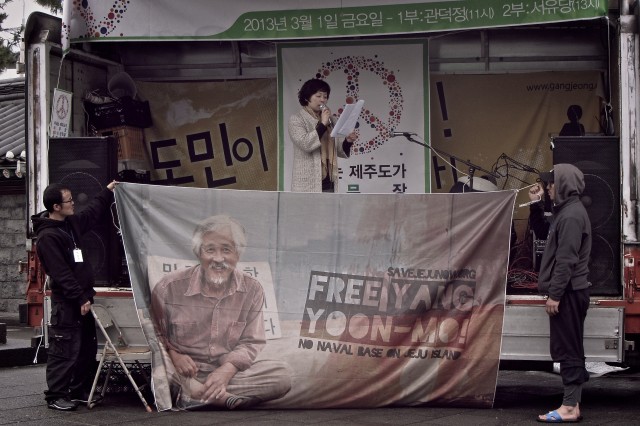
2. People’s statement to build the Jeju, Demilitarized Peace Island on March 1.
And here are the excerpts from the people’s statement on March 1. To see the full statement in Korean, see here:
[..] The Jeju Island has been used as a bridgehead for the Mongol to invade Japan during the period of people’s resistance against Mongol [in the 13th century].
It was used as an overseas site for the Japanese military to bomb China in the China-Japan war during the period of Japanese occupation [in 1937].
It has been strained to a breaking point as Japan built the whole Island as a military stronghold at the end of her imperialism [in 1945].
As such, the Jeju Island has often taken a role of military base because of its geopolitical importance.
During the 4.3 period (* 1947 to 1954), Rhee Seung Man, [the puppet government under the United Sates] said that he would let the United States to build a permanent base in the Jeju.
In 1970, President Park Chung-Hee, [the father of Park Geun-Hye, the new South Korean President who was inaugurated on Feb. 25, 2013] said that he would provide the Jeju Island as a new US base in replacement of Okinawa.
Since the construction of the air base, Songak Mt., Moseulpo, about 20 years ago was stranded, the government is building a naval base in Gangjeong after it attempted [but failed] it in Hwasoon and Weemee.
However, the Jeju Island is the World Peace Island!
In last 2005, the ‘Government designated the Jeju Island as the world Peace Island so that the tragedy of Jeju 4.3 can be sublimed with cooperation & co-existence and contribute to the peace of world.
The Jeju Island that has endlessly suffered and been sacrificed by the domestic and overseas power has finally become to rise into a new epicenter of peace.
However, such efforts for the Demilitarized Peace Island has gradually become collapsed as the naval base became to be driven in the Jeju.
We don’t want the Jeju positioned at the intersection point of continent and maritime to be the arena of competition between two powers.
Rather, we pray for it to become the outpost for peace as a buffer zone between the two powers.
It is to build the Peace Island in Jeju, with neither military nor military base, neither war nor violence.
It is to accomplish preservation on nature and protection on environment by clarifying opposition to all the thoughtless developments.
It is to plan for the precious lives’ native growth, opposing the terror to all the lives.
It is eventually to accomplish a self-reliant community of the permanent neutral to which no intervention by a foreign or other powers reach.
That is the essence of the Jeju Demilitarized Peace Island.
On March 1, we, here in the Gwandeokjeong being alive by the spirit of the patriotic forefathers who resisted to wicked foreign powers and tried to save the precious Jeju community,
Are to abandon collapse and destruction, the products of war and violence,
Are to accomplish resurrection and restoration, the fruits of peace and co-existence.
For that, we make resolution to realize the Demilitarized Peace Island through constant practices and peaceful efforts.
We, confirming our determination and practical will, also declare that we would step together with all the conscientious citizens in the world including Jeju.
March 1, 2013
People who make the Jeju as the Demilitarized Peace Island
3. Yang Yoon-Mo’s prison fast inspires overseas

On Feb. 28, Mr Koh Gilchun, Jeju artist, Oh Soon-Hee, a director of a small theater, and a village international team member visited Prof yang who hit 28th prison fast as of Feb. 28.
Known later… Ms. Oh Soon-Hee is a sister of Mr Oh Myul, a movie director of Jiseul, the Sundance grand prize 4.3 movie.
Thin though, Prof. yang looked bright. He has been in a sick room of the prison for 10 days. in the sick room, he stays with two other people and was wearing a patient cloth.
He has recently begun to take enzyme as he feels powerless.
He said he is getting many support letters from the domestic and international. Even though he wants to reply to them, he feels so energy-less. So he asked to deliver his great thanks to all the domestic and international friends.
Regarding the march 1 event, he said he is pleased for two things.
First, he is pleased that the 4.3 movie ‘Jiseul’, begins to screen on March 1. He wished that at least about 30,000 people could see the movie. it is known that at least 30,000 people were sacrificed during the 4.3 period, 1947 to 1954.
Oh Soon-Hee said that she got the contact from the movie theater manager on Feb. 27 that he would increase the daily screening numbers of Jiseul from 6 to 11 as many people are more and more interested in the movie. she also said the Jiseul team is considering to screen the English subtitled once a day.
Prof yang also said that he is pleased to see a meaningful 3. 1 event , the 2nd event for Jeju demilitarized, commemorating the fuse of 3.1, 1947, when 6 people were killed by the police under the governing of the US military government and became the fuse of 4.3 incident. he said he hopes this could be a momentum for many Jeju island people to be aware of the importance of the jeju as the demilitarized and self reliant .
A postcard from Benj and Five postcards from Okinawa were delivered to Prof Yang. T shirt from Benj (photo) was shown to Yang and he was very pleased. Thanks so much, Benj and friends from Okinawa.
Otherwise, on March 4, Ishle Yi Park‘s message was sent through Benj
‘Aloha,
Hope you are well and in light. I am a mother, poet and activist (Poet Laureate of Queens, 2004-2007) who is currently fasting in Hawai’i in solidarity with Professor Yang Yoon-Mo and the beloved people of Jejudo.
I am currently on my fifth day of my fast, and plan on fasting as long as Professor Yang is fasting. Would greatly appreciate an update on his status, how his health is, and if he is still fasting, how long he plans to fast.
I am a nursing mother, so this fast is a big deal for me. I’ve been to Jeju several times, have written numerous poems in praise and tribute for the island, and hold a special place in my heart for Jejudo haenyos (Sea diving women)as well. My prayers and well wishes are with you all, for caring about our beloved island and our future generations.
Thank you so much, and look forward to hearing from you very soon.
God bless, and Peace to Jeju,
Ishle Yi Park’
4. Struggle for Gangjeong and Jeju is one matter.
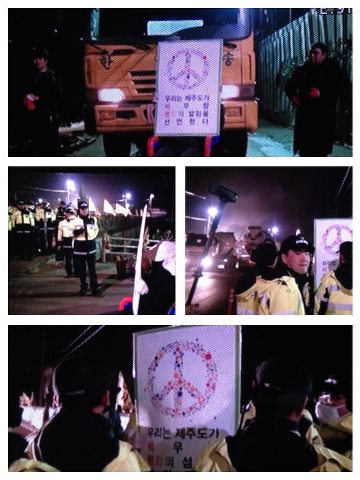
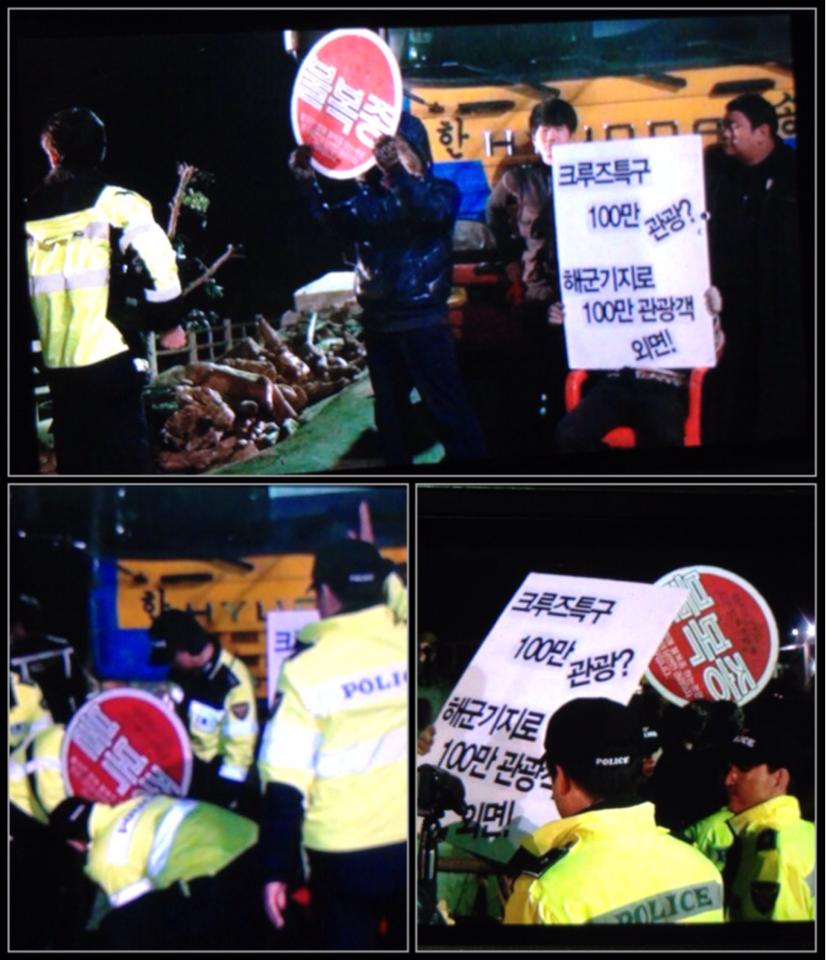
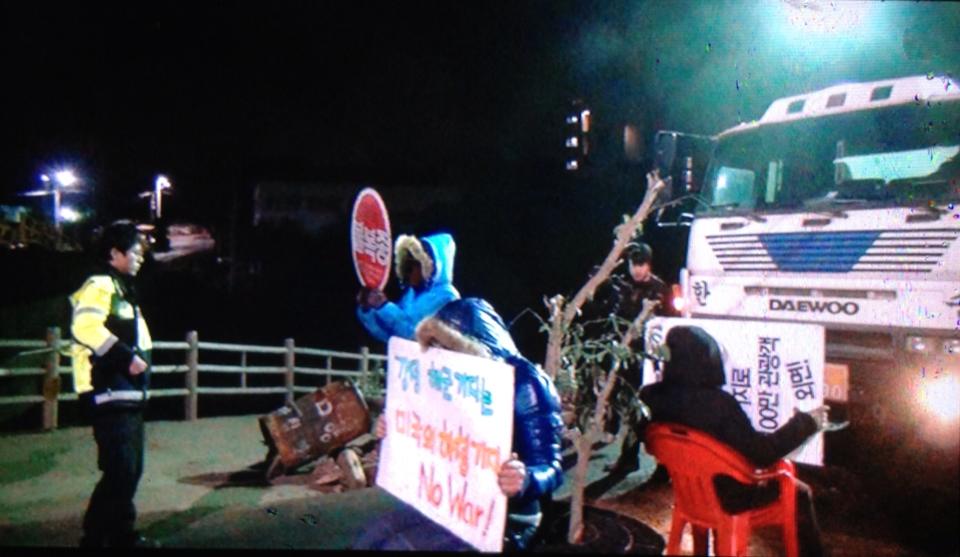
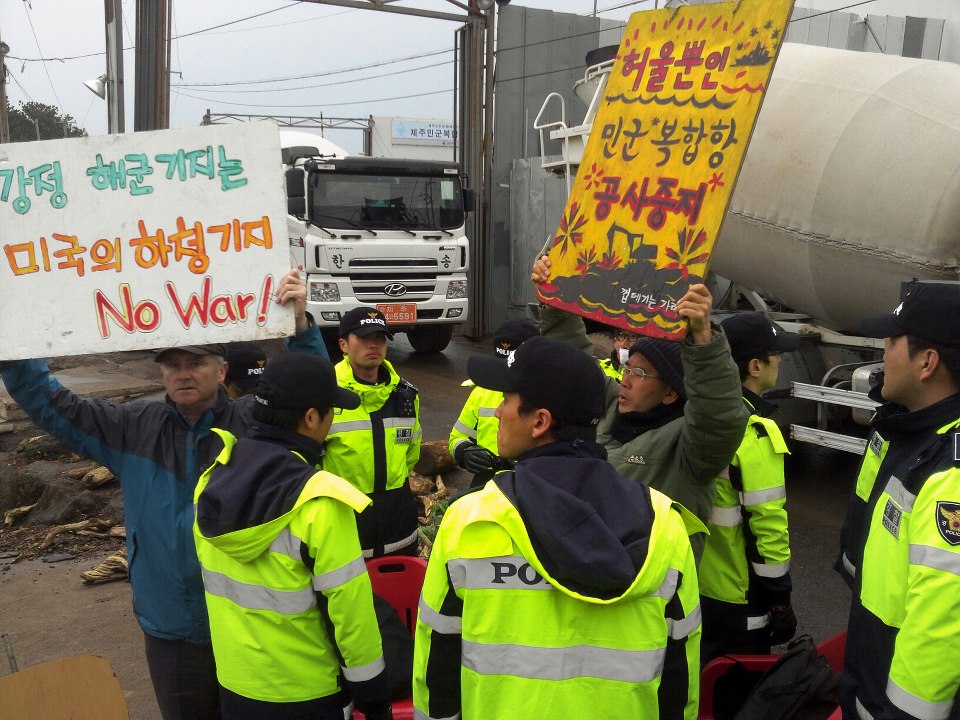
‘The Gangjeong Naval base is the sub-contract base for the US. No War!’/
‘Fr Kim Sung Hwan SJ and Pat Cunningham SSC at the gate in Gangjeong on Independence Movement Day (삼일절) protesting against the occupation of the village by modern day forces preparing for war under the banner of ‘national security’ while all the while jeopardizing the future of lasting peace and security on the Island of Peace! The building of the naval base only serves to dishonor the memory of all who sacrificed their lives for peace and freedom and increases tension and insecurity among people on the island and in the wider region! ( script by Pat Cunningham )
